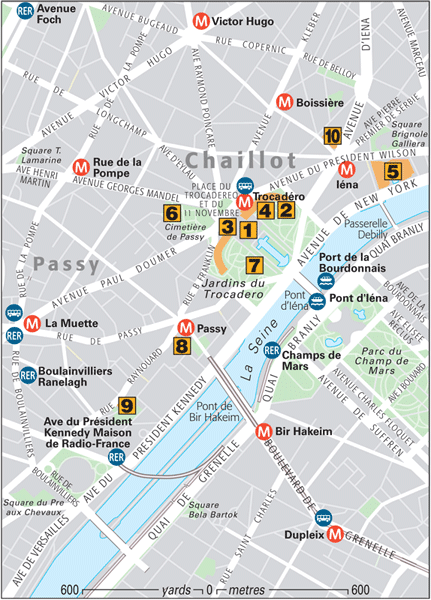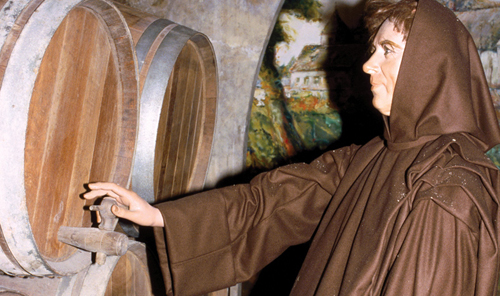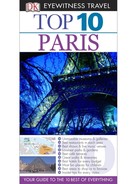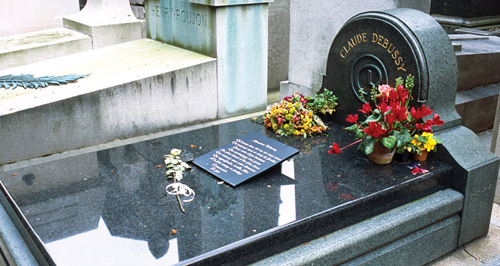Chaillot Quarter
Chaillot was a separate village until the 19th century, when it was swallowed up by the growing city and bestowed with wide avenues and lavish mansions during the Second Empire building spree. Its centrepiece is the glorious Palais de Chaillot which stands on top of the small Chaillot hill, its wide white-stone wings embracing the Trocadéro Gardens and its terrace gazing across the Seine to the Eiffel Tower. Behind the palace is the place du Trocadéro, laid out in 1858 and originally called the place du Roi-de-Rome (King of Rome), the title of Napoleon’s son. The square is ringed with smart cafés, overlooking the central equestrian statue of World War I hero Marshal Ferdinand Foch. Many of the elegant mansions in this area now house embassies, and there are numerous fine dining spots. To the west are the exclusive residential neighbourhoods of the Parisian bourgeoisie.
General FochGeneral Ferdinand Foch (1851–1929), whose statue stands in the centre of place du Trocadéro, was the commander-in-chief of the Allied armies by the end of World War I. His masterful command ultimately led to victory over the Germans in 1918, whereupon he was made a Marshal of France and elected to the French Academy. |


|
Sights
Palais de Chaillot
The fall of his empire scuppered Napoleon’s plans for an opulent palace for his son on Chaillot hill, but the site was later used for the Trocadéro palace, built for the Universal Exhibition of 1878. It was replaced by the present Neo-Classical building with its huge colonnaded wings for the prewar exhibition of 1937. The two pavilions house three museums, including the Musée de l’Homme. The broad terrace is the domain of souvenir sellers and skate-boarders by day, while at night it is crowded with busloads of tour groups stopping off for the splendid view of the Eiffel Tower across the Seine. Two bronzes, Apollo by Henri Bouchard and Hercules by Pommier, stand to the front of the terrace. Beneath the terrace is the 1,200-seat Théâtre National de Chaillot.
17 pl du Trocadéro, 75016

Cinéaqua
Originally built in 1878 for the Universal Exhibition, Paris’ aquarium reopened in 2006 after a 21-year closure. It is home to over 500 species, including seahorses, stonefish and some spectacular sharks and rays. Built into a former quarry, the site has been designed to blend in with the Chaillot hillside. There is also a futuristic cinema complex, the Movieum.
Ave Albert de Mun, 75016
Open 10am–10pm daily
Admission charge
Cinéaqua 2 ave des Nations Unies, 75016
Musée de la Marine
French naval history is the focus of this museum, whether in war, trade and commerce, or industries such as fishing. The displays range from naval art to science to maritime adventure and popular legends and traditions. Among the highlights is an outstanding collection of model ships, from the feluccas of ancient Egypt, to medieval galleys to nuclear submarines. You can also watch craftsmen at work on the models. Napoleon’s royal barge is also on show (see Museums).
Palais de Chaillot, 75016
Open 10am–6pm Wed–Mon
Closed 1 Jan, 1 May, 25 Dec
Admission charge

Cité de l’Architecture et du Patrimoine
Occupying the east wing of the Palais Chaillot (together with the Musée de l’Homme), this museum is a veritable ode to French architectural heritage, showcasing its development through the ages as well as contemporary architecture. The Galerie des Moulages (Medieval to Renaissance) contains moulded portions of churches and great French cathedrals such as Chartres. The Galerie Moderne et Contemporain includes a reconstruction of an apartment designed by Le Corbusier, and architectural designs from 1990 onwards. The wall-painting gallery in the Pavillon de Tête has a stunning collection of murals copied from medieval frescoes.
Palais de Chaillot, 75116
Open 11am–7pm Wed–Mon (until 9pm Thu)
01 58 51 52 00
Admission charge
Musée d’Art Moderne de la Ville de Paris
This modern art museum is housed in the east wing of the Palais de Tokyo, built for the 1937 World Fair. Its permanent collection includes such masters as Chagall, Picasso, Modigliani and Léger; further highlights include Raoul Dufy’s enormous mural The Spirit of Electricity (1937), and Picabia’s Lovers (After the Rain) (1925). The museum is also keen to promote up-and-coming artists by showcasing their work in frequent temporary exhibitions on the same site.
11 ave du Président-Wilson, 75016
Open 10am–6pm Tue–Sun (until 10pm Thu during temporary exhibitions)
01 53 67 40 00
Admission charge

Cimetière de Passy
This small cemetery covers only 1 ha (2.5 acres), yet many famous people have been laid to rest here with the Eiffel Tower as their eternal view (see Graves in Cimetière de Passy). It is worth a visit just to admire the striking sculptures on the tombs.
d Pl du Trocadéro (entrance rue du Commandant Schloessing) 75016
Cimetière de Passy
Jardins du Trocadéro
Designed in 1937, the tiered Trocadéro Gardens descend gently down Chaillot Hill from the palace to the Seine and the Pont d’Iéna. The centrepiece of this 10-ha (25-acre) park is the long rectangular pool lined with stone and bronze statues, including Woman by Georges Braque (1882–1963). Its illuminated fountains are spectacular at night. With flowering trees, walkways and bridges over small streams, the gardens are a romantic place for a stroll (see Versailles Fountains).
Musée du Vin
The vaulted 14th-century cellars where the monks of Passy once made wine are an atmospheric setting for this wine museum. Waxwork figures depict the history of the wine-making process, and there are displays of wine paraphernalia. There are tasting sessions, wine for sale and a restaurant.
5 square Charles-Dickens, 75016
Open 10am–6pm Tue–Sun
Admission charge
Exhibit at the Musée du Vin
Maison de Balzac
The writer Honoré de Balzac (see Le Père Goriot) rented an apartment here from 1840–44, and assumed a false name to avoid his many creditors. He worked on several of his famous novels here, including La cousine Bette and La comédie humaine. The house is now a museum displaying first editions and manuscripts, personal mementoes and letters, and paintings and drawings of his friends and family.
47 rue Raynouard, 75016
Open 10am–6pm Tue–Sun
Closed public hols
Admission charge

Musée National des Arts Asiatiques-Guimet
One of the world’s foremost museums of Asiatic and Oriental art, founded by industrialist Emile Guimet in Lyon in 1879. The Khmer Buddhist temple sculptures from Angkor Wat are the highlight of the finest collection of Cambodian art in the west. Guimet’s original collection tracing Chinese and Japanese religion from the 4th to 19th centuries is also on display, as are artifacts from India, Indonesia and Vietnam.
6 pl d’Iéna, 75016
Open 10am– 6pm Wed–Mon
Admission charge
A Day in Chaillot
Morning
It would be hard to imagine a better start to a day in Paris than going to the Palais de Chaillot and seeing the perfect view it has across the Seine to the Eiffel Tower . Then tour the fascinating collections of the Cité de l’Architecture and, if marine history is your thing, the Musée de la Marine , both in the palace. Outside the palace, take a break in the Café du Trocadéro (
8 pl du Trocadéro01 44 05 37 00) and watch the comings and goings in the square.
Afterwards, head along rue Benjamin Franklin and rue Raynouard, where you will find first the Musée du Vin and the Maison de Balzac. Walk to the far side of the Maison de Radio France building for a brunch or lunch at Zebra Square .
Afternoon
Revived, walk back along the Seine towards the Palais de Chaillot, and head up to the place d’Iéna to the recently refurbished and much improved Musée National des Arts Asiatiques Guimet for its spectacular Eastern artworks.
By now you will definitely be in need of a rest, so return to the place du Trocadéro for a coffee at the Café Kléber No. 4 (01 47 27 86 65). End the day in the peaceful Cimetière de Passy before an unforgettable dinner overlooking the Eiffel Tower at the stylish Café de l’Homme .
Graves in Cimetière de Passy
Edouard Manet
Born in Paris in 1832, Manet became the most notorious artist in the city when works such as Olympia and Le Déjeuner sur l’Herbe were first exhibited. He died in Paris in 1883.
Manet bust
Berthe Morisot
The French Impressionist artist was born in Paris in 1841, posed for Edouard Manet and later married his lawyer brother Eugène. She never achieved the fame of the male Impressionists and died in Paris in 1895.
Marie Bashkirtseff
This Russian artist became more renowned as a diarist after her death from tuberculosis in 1884. Despite living for only 24 years she produced 84 volumes of diaries and their posthumous publication created a sensation due to their intimate nature.
Henri Farman
The French aviator was born in Paris in 1874 and died here in 1958. He was the first man to make a circular 1-km (0.5-mile) flight, and the first to fly cross-country in Europe. His gravestone shows him at the controls of a primitive plane.
Antoine Cierplikowski
The grave of this fairly obscure artist of the 1920s attracts attention because of its immensely powerful sculpture of a man and woman joined together and seeming to soar from the grave to the heavens.
Comte Emanuel de las Cases
Born in 1766, this historian and friend of Napoleon shared the emperor’s exile on the island of St Helena and recorded his memoirs. The Comte himself died in Paris in 1842.
Gabriel Fauré
The French composer, probably best known today for his Requiem, was a great influence on the music of his time. He died in Paris in 1924, at the age of 79.
Octave Mirbeau
The satirical French novelist and playwright was also an outspoken journalist. Born in 1848, he died in Cheverchemont in 1917 and his body was brought to Passy for burial.
Places to Eat

La Table de Babette
This high-class West Indian restaurant is run by star chef Babette de Rozières. Expect exotic dishes such as stuffed crab with chilies and bananas flambéed in rum.
32 rue de Longchamp, 75016
01 45 53 00 07
Closed Sat L, Sun, Aug
Café de l’Homme
Ultra-cool, stylish restaurant serving inventive, fusion cuisine at the top of the Palais de Chaillot.
Musée de l’Homme, 7 place du Trocadero, 75016
01 44 05 30 15
Café de l’Homme
L’Astrance
Pascal Barbot serves fusion food at its best. Book at least one month in advance.
4 rue Beethoven 75116
01 40 50 84 40
Closed Sat & Mon
No disabled access
Maison Prunier
Fish dishes reign at this restaurant with 1930s decor.
16 ave Victor-Hugo, 75016
01 44 17 35 85
Closed Sun, end Jul–end Aug
No disabled access
Le Scheffer
Superb food, friendly, and reasonable prices, so book ahead. Try the red mullet Provençale.
22 rue Scheffer, 75016
01 47 27 81 11
Closed Sat, Sun, Jul–Aug
Le Petit Rétro
Cosy atmosphere in this 1900s bistro and affordable prices. Blanquette de Veau is delicious.
5 rue Mesnil, 75016
01 44 05 06 05
Closed Sat L, Sun, Aug
No disabled access
Le Bistrot des Vignes
Unpretentious little bistro of the type everyone hopes to find in Paris.
1 rue Jean-Bologne, 75016
01 45 27 76 64
Closed Sun
No disabled access
La Table Lauriston
Serge Barbey believes in the best ingredients prepared simply. La Table Lauriston is a hit with local gourmets who tuck into his gargantuan steak and rum-doused baba in the jewel-toned dining room.
129 rue Lauriston, 75116
01 47 27 00 07
Closed Sun, Sat L
|





